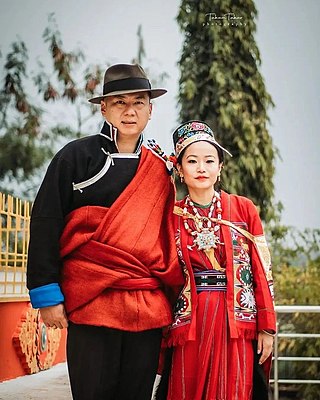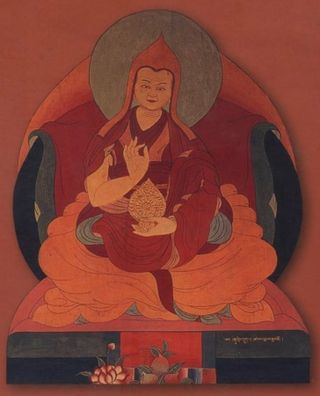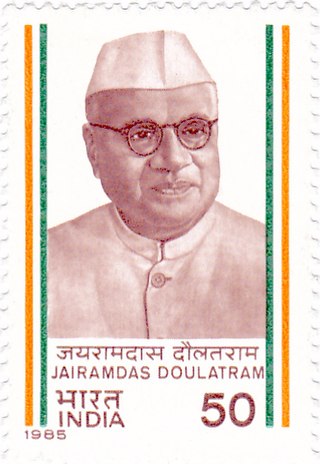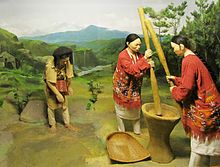
Arunachal Pradesh is a state in northeast India. It was formed from the North-East Frontier Agency (NEFA) region, and India declared it as a state on 20 February 1987. Itanagar is its capital and largest town. It borders the Indian states of Assam and Nagaland to the south. It shares international borders with Bhutan in the west, Myanmar in the east, and a disputed 1,129 km border with China's Tibet Autonomous Region in the north at the McMahon Line. Arunachal Pradesh is claimed by China as part of the Tibet Autonomous Region; China occupied some regions of Arunachal Pradesh in 1962 but later withdrew its forces.

The Monpa is a major tribe of Arunachal Pradesh in northeastern India. The Tawang Monpas have a migration history from Changrelung. The Monpa are believed to be the only nomadic tribe in Northeast India – they are totally dependent on animals like sheep, cow, yak, goats and horses. The Monpa have a very close affinity with the Sharchops of Bhutan.
The Buguns are one of the earliest recognized schedule tribe of India, majority of them, inhabiting the Singchung Sub-Division of West Kameng District of Arunachal Pradesh. Buguns live in several exogamous clans. Traditionally, the predominant occupation was agriculture, supported with other allied activities like fishing and hunting, cattle rearing etc. Buguns have their own folklores, songs, dances, music and rituals. A rare bird, the Bugun liocichla, was named after the tribe.
The Lishipa is a tribal group found in the Dirang area in the West Kameng district of Arunachal Pradesh in India.

Tawang district is the smallest of the 26 administrative districts of Arunachal Pradesh state in northeastern India. With a population of 49,977, it is the eighth least populous district in the country.

West Kameng is a district of Arunachal Pradesh in northeastern India. It accounts for 8.86% of the total area of the state. The name is derived from the Kameng river, a tributary of the Brahmaputra, that flows through the district.
The Hrusso and Aka have bifurcated among themselves and are now regarded as separatetribes of Arunachal Pradesh according to Constitution Ammendment Act, 2021.

Nyishi community is the largest ethnic group in Arunachal Pradesh in north-eastern India. The Nyishi language belongs to the Sino-Tibetan family, however, the origin is disputed. Their population of around 300,000 makes them the most populous tribe of Arunachal Pradesh, closely followed by the tribes of the Adi according to 2001 census.

Tsangyang Gyatso was the 6th Dalai Lama. He was an unconventional Dalai Lama that preferred a libertine lifestyle to that of an ordained monk. His regent was killed before he was kidnapped by Lha-bzang Khan of the Khoshut Khanate and disappeared.

The Miji, are a social group of Arunachal Pradesh, India. They are located in various districts of Arunachal Pradesh including the West Kameng, East Kameng and Kurung Kumey.Their population of 37,000 are found near the lower parts of the sub-Himalayan hills bordering Assam; they speak the Sajalong language.
The Indian state of Arunachal Pradesh has a total population of roughly 1.4 million on an area of 84,000 km2, amounting to a population density of about 17 pop./km2. The "indigenous groups" account for about two thirds of population, while immigrants, mostly of Bengali/Hindi belt origin, account for the remaining third.
The Nah people are a small tribal group residing in the Indian state of Arunachal Pradesh. They speak the Na language, a member of the Sino-Tibetan language family, in which the population's literacy rate is 30%. The Na language has an affinity with the Tagin language. They also use Hindi or English. As of 2000, the tribal population stood at 1,500.

Bomdila is the headquarters of West Kameng district in the state of Arunachal Pradesh in India. Bomdila is one of the 60 constituencies of the state of Arunachal Pradesh.

Sonitpur district [Pron: ˌsə(ʊ)nɪtˈpʊə or ˌʃə(ʊ)nɪtˈpʊə] is an administrative district in the state of Assam in India. The district headquarters is located at Tezpur.

Tawang is a town and administrative headquarter of Tawang district in the Indian state of Arunachal Pradesh. It lies on NH-13 section of Trans-Arunachal Highway. The town was once the headquarter of the Tawang Tract, which is now divided into the Tawang district and the West Kameng district. Tawang continues as the headquarters of the former. Tawang is the number one tourist destination of Arunachal Pradesh.

Udalguri district (Pron:ˌʊdʌlˈgʊəri), also known as Odalguri, is a district in the Bodoland Territorial Region of the state of Assam in Northeastern India. Udalguri town is the headquarters of the district.
The Kho-Bwa languages, also known as Kamengic, are a small family of languages spoken in Arunachal Pradesh, northeast India. The name Kho-Bwa was originally proposed by George van Driem (2001). It is based on the reconstructed words *kho ("water") and *bwa ("fire"). Blench (2011) suggests the name Kamengic, from the Kameng area of Arunachal Pradesh. Alternatively, Anderson (2014) refers to Kho-Bwa as Northeast Kamengic.

Tawang Monastery is a Buddhist monastery located in Tawang, Arunachal Pradesh, India. It is the largest monastery in the country. It is situated in the valley of the Tawang Chu, in close proximity to the Chinese and Bhutanese border.

Jairamdas Daulatram (1891–1979) was an Indian political leader from Sindh, who was active in the Indian independence movement and later served in the Government of India. He was appointed as the Governor for the states of Bihar and later Assam. He played a key role in strengthening the North-East Frontier Tracts of India in the face of the Chinese annexation of Tibet, and managed the Indian integration of Tawang in 1951.
Sherdukpen is a small language of India. It is one of the Kho-Bwa languages. There are two distinct varieties, Mey of Shergaon and Mey of Rupa. The name Sherdukpen comes from the words Shergaon and Tukpen. The language is known to speakers as Mey nyuk.














